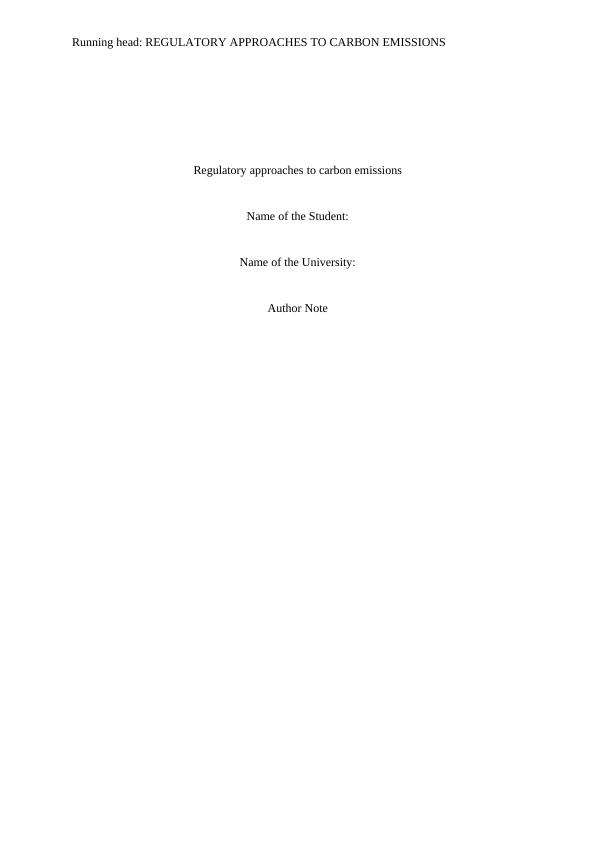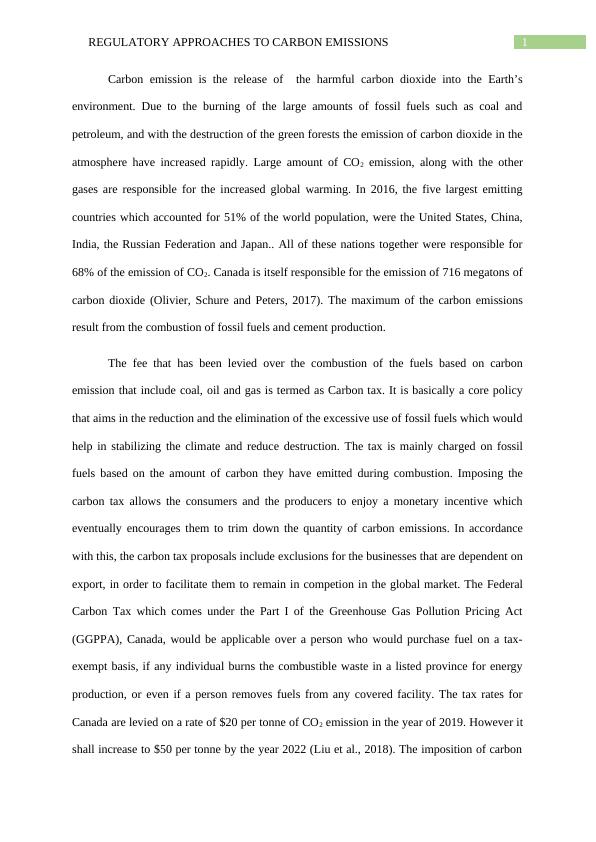Regulatory Approaches to Carbon Emissions
Added on 2022-11-23
7 Pages1915 Words332 Views
Running head: REGULATORY APPROACHES TO CARBON EMISSIONS
Regulatory approaches to carbon emissions
Name of the Student:
Name of the University:
Author Note
Regulatory approaches to carbon emissions
Name of the Student:
Name of the University:
Author Note

1REGULATORY APPROACHES TO CARBON EMISSIONS
Carbon emission is the release of the harmful carbon dioxide into the Earth’s
environment. Due to the burning of the large amounts of fossil fuels such as coal and
petroleum, and with the destruction of the green forests the emission of carbon dioxide in the
atmosphere have increased rapidly. Large amount of CO2 emission, along with the other
gases are responsible for the increased global warming. In 2016, the five largest emitting
countries which accounted for 51% of the world population, were the United States, China,
India, the Russian Federation and Japan.. All of these nations together were responsible for
68% of the emission of CO2. Canada is itself responsible for the emission of 716 megatons of
carbon dioxide (Olivier, Schure and Peters, 2017). The maximum of the carbon emissions
result from the combustion of fossil fuels and cement production.
The fee that has been levied over the combustion of the fuels based on carbon
emission that include coal, oil and gas is termed as Carbon tax. It is basically a core policy
that aims in the reduction and the elimination of the excessive use of fossil fuels which would
help in stabilizing the climate and reduce destruction. The tax is mainly charged on fossil
fuels based on the amount of carbon they have emitted during combustion. Imposing the
carbon tax allows the consumers and the producers to enjoy a monetary incentive which
eventually encourages them to trim down the quantity of carbon emissions. In accordance
with this, the carbon tax proposals include exclusions for the businesses that are dependent on
export, in order to facilitate them to remain in competion in the global market. The Federal
Carbon Tax which comes under the Part I of the Greenhouse Gas Pollution Pricing Act
(GGPPA), Canada, would be applicable over a person who would purchase fuel on a tax-
exempt basis, if any individual burns the combustible waste in a listed province for energy
production, or even if a person removes fuels from any covered facility. The tax rates for
Canada are levied on a rate of $20 per tonne of CO2 emission in the year of 2019. However it
shall increase to $50 per tonne by the year 2022 (Liu et al., 2018). The imposition of carbon
Carbon emission is the release of the harmful carbon dioxide into the Earth’s
environment. Due to the burning of the large amounts of fossil fuels such as coal and
petroleum, and with the destruction of the green forests the emission of carbon dioxide in the
atmosphere have increased rapidly. Large amount of CO2 emission, along with the other
gases are responsible for the increased global warming. In 2016, the five largest emitting
countries which accounted for 51% of the world population, were the United States, China,
India, the Russian Federation and Japan.. All of these nations together were responsible for
68% of the emission of CO2. Canada is itself responsible for the emission of 716 megatons of
carbon dioxide (Olivier, Schure and Peters, 2017). The maximum of the carbon emissions
result from the combustion of fossil fuels and cement production.
The fee that has been levied over the combustion of the fuels based on carbon
emission that include coal, oil and gas is termed as Carbon tax. It is basically a core policy
that aims in the reduction and the elimination of the excessive use of fossil fuels which would
help in stabilizing the climate and reduce destruction. The tax is mainly charged on fossil
fuels based on the amount of carbon they have emitted during combustion. Imposing the
carbon tax allows the consumers and the producers to enjoy a monetary incentive which
eventually encourages them to trim down the quantity of carbon emissions. In accordance
with this, the carbon tax proposals include exclusions for the businesses that are dependent on
export, in order to facilitate them to remain in competion in the global market. The Federal
Carbon Tax which comes under the Part I of the Greenhouse Gas Pollution Pricing Act
(GGPPA), Canada, would be applicable over a person who would purchase fuel on a tax-
exempt basis, if any individual burns the combustible waste in a listed province for energy
production, or even if a person removes fuels from any covered facility. The tax rates for
Canada are levied on a rate of $20 per tonne of CO2 emission in the year of 2019. However it
shall increase to $50 per tonne by the year 2022 (Liu et al., 2018). The imposition of carbon

2REGULATORY APPROACHES TO CARBON EMISSIONS
tax is for the purpose of lowering of the greenhouse gas emissions. Imposition of carbon tax
on the people encourages them to use alternative usage of energies. Thus it is cost-
competitive with cheaper fuels. The carbon tax helps to raise the money that supports the
different environmental programmes and also issue them as a refund (Makholm, 2015). This
eventually helps in the progressive tax-shifting. Also the tax burdens are shifted from the
federal income tax and the state sales tax. Since the carbon tax imposed by the government is
a fixed price over the carbon, everyone must be paying it. It is relatively easier to administer
and comprehend the policy as everyone pays the exact same price for the combustion of
carbon. However apart from it advantages, it does have certain negatives. It does not set an
exact amount on the emissions (Tietenberg, 2013). The price is just set by the government
and the common public is expected to perform the rest of the activities. Canada is in a severe
risk and the problem of carbon emissions is quite acute.
Carbon trading is a process which is also aimed at effective control of carbon dioxide
pollution. It also provides economic incentives in order to achieve the goal of emission
reduction. Carbon trading is usually administered under the authority of any international
organization or government. Unlike the carbon tax, carbon trading involves a set limit or cap
over the amount of carbon dioxide emission. It is often called “cap and trade” (Filgueira et
al., 2015). After capping the amount of carbon emission, a permit is imposed by the
government over the companies specifying their limit of combustion. If any company wants
to burn more carbon, than what is permitted to it, there is a requirement of it to seek extra
permits from the other companies who have burned less carbon (Almutairi & Elhedhli, 2014).
Cap and trade gives the government more mechanisms in order to target the cost to industry,
not only the individuals. The advantages of carbon trading is that the government can have a
dictating power over the exact amount of carbon and greenhouse emissions and have the
authority to modify the sale of carbon permits in order to reach its reduction goals. However
tax is for the purpose of lowering of the greenhouse gas emissions. Imposition of carbon tax
on the people encourages them to use alternative usage of energies. Thus it is cost-
competitive with cheaper fuels. The carbon tax helps to raise the money that supports the
different environmental programmes and also issue them as a refund (Makholm, 2015). This
eventually helps in the progressive tax-shifting. Also the tax burdens are shifted from the
federal income tax and the state sales tax. Since the carbon tax imposed by the government is
a fixed price over the carbon, everyone must be paying it. It is relatively easier to administer
and comprehend the policy as everyone pays the exact same price for the combustion of
carbon. However apart from it advantages, it does have certain negatives. It does not set an
exact amount on the emissions (Tietenberg, 2013). The price is just set by the government
and the common public is expected to perform the rest of the activities. Canada is in a severe
risk and the problem of carbon emissions is quite acute.
Carbon trading is a process which is also aimed at effective control of carbon dioxide
pollution. It also provides economic incentives in order to achieve the goal of emission
reduction. Carbon trading is usually administered under the authority of any international
organization or government. Unlike the carbon tax, carbon trading involves a set limit or cap
over the amount of carbon dioxide emission. It is often called “cap and trade” (Filgueira et
al., 2015). After capping the amount of carbon emission, a permit is imposed by the
government over the companies specifying their limit of combustion. If any company wants
to burn more carbon, than what is permitted to it, there is a requirement of it to seek extra
permits from the other companies who have burned less carbon (Almutairi & Elhedhli, 2014).
Cap and trade gives the government more mechanisms in order to target the cost to industry,
not only the individuals. The advantages of carbon trading is that the government can have a
dictating power over the exact amount of carbon and greenhouse emissions and have the
authority to modify the sale of carbon permits in order to reach its reduction goals. However

End of preview
Want to access all the pages? Upload your documents or become a member.
Related Documents
Assignment on Carbon Taxlg...
|6
|981
|135
Carbon Capture and Storage Report 2022lg...
|21
|5597
|30
Carbon Tax System in Canadalg...
|11
|2781
|13
CO2 Emission Reduction Studylg...
|8
|1481
|47
Study On Water Scarcity & Large Power-cut Issue In UKlg...
|9
|2354
|70
Carbon dioxide as air pollutantlg...
|17
|5558
|359